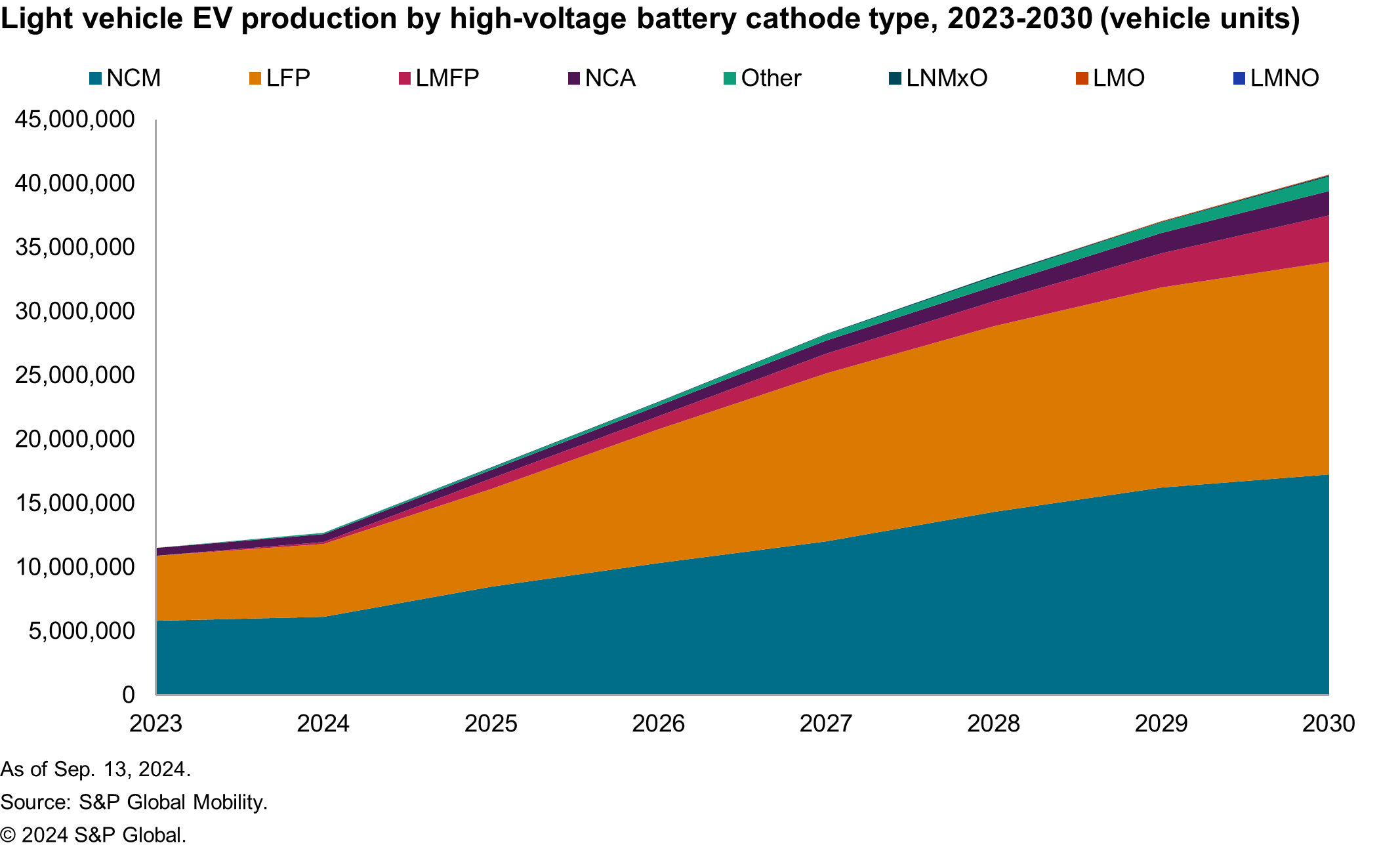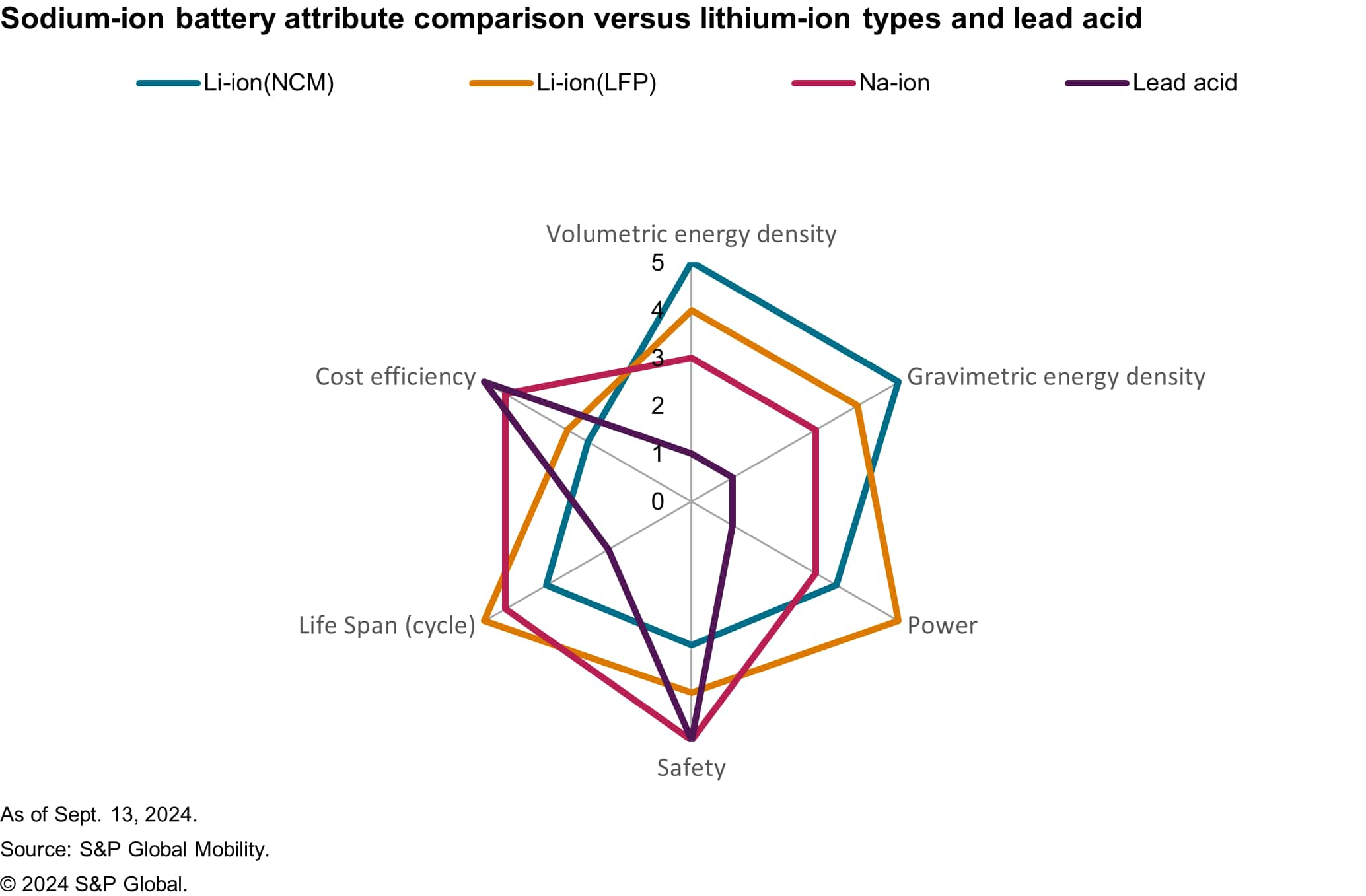Discover more about S&P Global's offerings
Customer Logins
Obtain the data you need to make the most informed decisions by accessing our extensive portfolio of information, analytics, and expertise. Sign in to the product or service center of your choice.
Customer Logins
BLOG
Nov 18, 2024
The Evolution of Electric Vehicle Battery Technology
The evolution of EV battery technology reflects a combination of historical developments, emerging innovations, and market demands.
The lithium-ion battery — now synonymous with electric vehicles (EVs) and available commercially since 1981 — took a while to catch on in automotive circles. The first EV had a lead acid battery and was developed a full 100 years earlier by Gustav Trouvé in 1881.
Indeed, by 1900, of the 4,192 vehicles produced in the US that year, 1,575 (38%) were electric. Vehicle speeds were low at that time and a lead acid battery was sufficient to give 100 miles of range. However, as vehicle speeds increased and requirements changed, the lead acid battery was no longer sufficient. EVs quickly fell by the wayside as the internal combustion engine (ICE) dominated.
Then in 1996, General Motors (GM) — acting upon a California Air Resources Board (CARB) mandate for zero-emission vehicles (ZEVs) — introduced its first generation EV1. This vehicle again had a lead acid battery. Like its EV counterparts earlier in the century, the EV1 could not stand toe-to-toe with ICE competitors as the lead acid battery lacked the energy density (volumetric and gravimetric) to compete. Even the second generation EV1, this time with a more energy-packed nickel metal hydride battery, could not compete with the ICE.
These developments took place with lithium-ion as a bystander, even though it provides up to three times the energy density (volumetric and gravimetric) of lead acid and approximately two times the density of nickel metal hydride.
At the same time as GM was tinkering with the EV1, in Japan Nissan launched the Altra EV in 1998 to little fanfare. The Altra is significant in that it was the first EV equipped with a lithium-ion battery. It never caught on. It was not until the lithium-ion-equipped Tesla Roadster was launched in 2008 that a fire was lit under the EV market and lithium-ion became mainstream.
The main lithium-ion battery chemistries
That is not where the story ends with lithium-ion. The phrase "lithium-ion" is actually catchall for various cathode (a battery's positive electrode) chemistries involving lithium. Material for the anode (the negative electrode) is pretty set, with graphite universally accepted as the material of choice, albeit with silicon increasingly added to the mix to improve energy density at the cost of a reduced cell cycle life.
In the first applications of lithium-ion, the cathode chemistry choice was between lithium in combination with oxides of nickel, cobalt or manganese. Nickel was favored for its energy density, cobalt for its reversibility, and manganese for its safety. Now, in lithium-ion batteries of this type, a cathode combining all three in varying ratios — NCM — is favored because of the attribute trade-offs noted above.
Until relatively recently, the NCM ratio was mainly 1:1:1. However, with the desire to reduce cost and improve sustainability (due to environmental concerns over cobalt mining) and energy density, the nickel ratio has been increased to the point that NCM 811 (8:1:1) has reached near ubiquity in the NCM type. The graph below shows the market makeup and forecast for the various NCM combinations.

The NCM811 combination holds sway over the market and will progressively increase its share. The so-called NCM90+, NCMA and HV NCM60 chemistries are also of note. NCM90+ denotes cathodes where the cobalt and manganese content is cut further (typical ratios can be 9:0.5:0.5 hence the 0 in the nomenclature) to improve energy density. NCMA batteries take the basis of the NCM battery and add aluminum to the mix for greater energy density.
All the above mostly relates to lithium-ion batteries of the NCM type (with a passing mention of NCA - nickel, cobalt, aluminum). Adding further complexity has been the advent of LFP (lithium iron phosphate) lithium-ion batteries, much favored by Chinese OEMs for their lower cost, enhanced thermal stability and the widespread availability of iron phosphate cathode materials. These attributes, together with the expiration of patents for LFP batteries in 2022, have seen heightened interest in the chemistry outside of Mainland China with European and North American-based OEMs building LFP supply chains.
As of now, LFP and NCM — in their various guises — dominate EV lithium-ion battery chemistries. In 2024, they are forecast to account for 94% of light vehicle EVs produced globally.

The following chart demonstrates the attribute trade-off between all the main competing cathode types for lithium-ion batteries. Writ large are the advantages that LFP has over competing chemistries. However, it falls short in energy density on both gravimetric and volumetric measures, meaning that larger LFP batteries are required to achieve the same range, particularly when compared with NCM and NCA types.
This shortcoming makes LFP batteries more suitable for light vehicles in smaller segments and in those vehicles where performance is less of an identifiable brand attribute. However, these shortfalls should not detract from the overall contribution that LFP batteries will make in electrifying light vehicle fleets, and they will be — and have been — a crucial factor in building momentum in more price-sensitive areas of the market.

What of sodium-ion and solid-state batteries?
As sales growth rates for EVs have recently stalled in major markets, attention is shifting to two emerging battery technologies — sodium-ion batteries (SIBs) and solid-state batteries (SSBs) — that may help revitalize the industry and address limitations of current technologies.
Due to the abundance of sodium compared with lithium, SIBs present a potentially cheaper alternative to lithium-ion batteries, including lithium iron phosphate (LFP) types. They avoid the complex supply chains required for lithium-ion mass production. Initially, SIBs were seen as suitable only for energy storage systems or low-performance two-wheelers. Although these segments will be where SIBs will be primarily used, recent developments suggest there is a niche within light vehicles that SIBs can cater to.

SIBs are likely to compete with LFP batteries, as their energy density is approximately 160 Wh/kg, compared to around 200 Wh/kg for LFP. This lower energy density, alongside a shorter life cycle, limits SIBs primarily to low-cost, entry-level vehicles.
Nonetheless, several factors could drive greater adoption of SIBs in the light-vehicle sector. Technologically, SIBs are safer, being less prone to thermal runaway, which can lead to fires. Sodium's lower reactivity reduces dendrite formation, a common failure mode in lithium-ion cells. Moreover, SIBs can operate efficiently over a wider temperature range, providing better performance in cooler conditions.
The primary advantages of SIBs lie in their material costs. According to S&P Global Mobility research, the material cost for SIBs is about 28% lower than LFP batteries. Additionally, SIB manufacturing processes are nearly identical to those of lithium-ion cells, meaning that suppliers can transition with minimal investment.
Despite their promise, SIB technology is still in its infancy within the light vehicle market. While limited production began in Mainland China this year, forecasts suggest SIBs will achieve only low single-digit market penetration by 2030.
The second technology worth considering is solid-state batteries (SSBs), which fundamentally alter lithium-ion battery design by replacing liquid electrolytes with solid ones. This transition is complex, with interim solutions involving semi-solid and almost-solid electrolytes also considered for development.
SSBs offer three significant benefits. First, they enhance safety; existing liquid and gel electrolytes are highly flammable, especially when used with high-nickel cathodes, which are less thermally stable.
Second, when paired with lithium metal anodes, SSBs can achieve energy densities 50%-80% higher than traditional high-nickel lithium-ion cells, allowing for greater vehicle range. For example, Nio recently launched its ES8 with a 150-kWh semi-SSB, boasting an energy density of 360 Wh/kg and a range of 930 km on the Chinese test cycle — about 20% more than the best current lithium-ion battery.
However, SSBs are not entirely risk-free; they can still suffer thermal runaway under extreme conditions or damage, and the melting point of lithium (180°C) poses challenges.
Despite these advantages, several hurdles exist for SSB adoption. The use of lithium metal anodes, which can lead to uneven plating and dendrite formation, poses risks to battery integrity. Additionally, solid electrolytes are less conductive, potentially limiting power output, especially in colder conditions. In some cases, external heating is necessary, particularly with polymer electrolytes.
Moreover, existing gigafactories designed for lithium-ion battery production will require significant re-investment to accommodate SSB manufacturing, complicating the transition. S&P Global Mobility estimates that by 2025, SSB costs will be around $500 per kWh — over five times the cost of lithium-ion batteries. This means that SSB packs will initially be more expensive even with higher energy density.
While some research indicates potential cost advantages for SSBs, they will remain pricier than lithium-ion batteries in the short- to medium-term. S&P Global Mobility forecasts that initial SSB applications will be in premium battery-electric and hybrid vehicles, where the greater range promised by SSBs is a significant selling point. Greater China and Europe will lead SSB production, accounting for over 73% of the forecasted 2.3 million SSB vehicles by 2034, with major automotive brands like Mercedes-Benz and BMW dominating the output.

Finally, as has been seen in this review of battery chemistries, cost is a major parameter in the decision-making tradeoffs OEMs and suppliers have to make in their pursuit of the right battery chemistry for their use case. Cost is also one of the main drivers of EV adoption. It was often held that EV sales would only take off once EV batteries achieved cost parity with the ICE. This level was deemed to be at the US$100 per kWh price point for the battery pack. Several chemistries are now at that level according to the cost model developed by S&P Global Mobility.

Conclusion
The evolution of EV battery technology reflects a combination of historical developments, emerging innovations, and market demands. Ultimately, the continued evolution of battery technology will be pivotal in driving the adoption of electric vehicles, making them more accessible and appealing to consumers while contributing to a more sustainable automotive landscape. The ongoing pursuit of cost-effective, high-performance batteries will not only influence the trajectory of the EV market but also play a crucial role in addressing global energy and environmental challenges.
Get high voltage battery forecast data
Watch the Webinar: Accelerating Sustainable Mobility through Battery Supply Chain Management
This article was published by S&P Global Mobility and not by S&P Global Ratings, which is a separately managed division of S&P Global.
{"items" : [
{"name":"share","enabled":true,"desc":"<strong>Share</strong>","mobdesc":"Share","options":[ {"name":"facebook","url":"https://www.facebook.com/sharer.php?u=http%3a%2f%2fstage.www.spglobal.com%2fmobility%2fen%2fresearch-analysis%2fthe-evolution-of-electric-vehicle-battery-technology.html","enabled":true},{"name":"twitter","url":"https://twitter.com/intent/tweet?url=http%3a%2f%2fstage.www.spglobal.com%2fmobility%2fen%2fresearch-analysis%2fthe-evolution-of-electric-vehicle-battery-technology.html&text=The+Evolution+of+Electric+Vehicle+Battery+Technology+%7c+S%26P+Global+","enabled":true},{"name":"linkedin","url":"https://www.linkedin.com/sharing/share-offsite/?url=http%3a%2f%2fstage.www.spglobal.com%2fmobility%2fen%2fresearch-analysis%2fthe-evolution-of-electric-vehicle-battery-technology.html","enabled":true},{"name":"email","url":"?subject=The Evolution of Electric Vehicle Battery Technology | S&P Global &body=http%3a%2f%2fstage.www.spglobal.com%2fmobility%2fen%2fresearch-analysis%2fthe-evolution-of-electric-vehicle-battery-technology.html","enabled":true},{"name":"whatsapp","url":"https://api.whatsapp.com/send?text=The+Evolution+of+Electric+Vehicle+Battery+Technology+%7c+S%26P+Global+ http%3a%2f%2fstage.www.spglobal.com%2fmobility%2fen%2fresearch-analysis%2fthe-evolution-of-electric-vehicle-battery-technology.html","enabled":true}]}, {"name":"rtt","enabled":true,"mobdesc":"Top"}
]}



